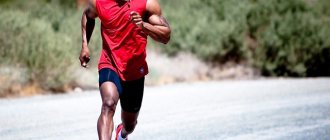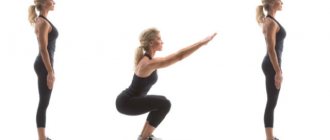Hello, dear readers! I’m with you on this page, Albert! Today, physical inactivity is considered the enemy of modern humanity.
And the easiest way to combat it is walking. This affordable physical activity helps you lose excess weight, relieve fatigue after a hard day, increase endurance and immunity.
Otherwise, insufficient physical activity, which provides people with the functioning of all muscle, joint and bone structures, can provoke the development of serious pathological processes in them. For example, in men with age - heart failure, and in women after menopause - osteoporosis.
Moreover, if a person wants to be healthy, he must constantly actively regulate his motor function. However, this option is purely individual.
After all, the average speed of a person when walking, running or skiing differs significantly. Therefore, I want to introduce you to these values, within what limits they fluctuate and how they are related to the state of human health.
Walking
A person moves mainly by walking or running. Their types depend on factors such as dynamics and tempo. Based on this, the following main types of walking can be determined:
- Walking. We do this kind of walking while walking. It is characterized by an imposing, slow pace, short steps at low speed, the average pedestrian speed does not exceed 4 km/h. The number of steps in one minute ranges from 50 to 70. A pedestrian’s pulse varies around 70–0 beats/min. The walk can hardly be called health-improving, because it does not carry any special physical or cardio load. The exceptions are people with musculoskeletal disorders or the elderly. Their movement at a slow pace is already an achievement. Most often, a person with such a gait rests during a leisurely walk.
- Walking at an average pace is characterized by a wider gait. From 70 to 90 steps are performed per minute. The average pedestrian speed is 4–6 km/h.
- Wellness. Characterized by a more accelerated pace. A person's walking speed can reach 7 km/h. The frequency of steps is from 70 to 120 per minute. The name of this species suggests that it has a healing effect. When moving at this pace, the heart rate increases, which improves blood circulation throughout the body and the functioning of all organs. At the pace of a healthy walk, a person hurries to the designated place.
- Sports. Its principle is to strive for maximum speed of movement, observing the principles and technique of walking, i.e., without switching to running. It is necessary to exclude the flight phase when moving. One of the feet should be in constant contact with the surface. This option requires good physical health, because you can walk even faster than run. A professional “walker” can reach speeds of up to 16 km/h. During competitions, the heart rate rises to 180 beats/min. Race walking is especially useful for women, because it helps improve their figure.
Important! During movement, body stability increases compared to a standing position. This explains why standing is more difficult than walking.
How long is it recommended to walk each day?
Everyone has probably heard about 10 thousand steps a day to get rid of all diseases and problems? As in the case of 2 liters of water, this is a stereotype. And it comes from Japan, where the inventor of the first electronic pedometer, Yoshiro Hatano, called it Mampo-kei. Translated into Russian, this means “10,000 steps.” One version of why Yoshiro named his invention this way is that it’s just a beautiful round number.
10,000 steps is approximately 8 km. And many, of course, are frightened by this figure. There is no need to take it literally, because there are a lot of variables: what surface a person moves on, at what speed, in what weather conditions and, finally, what kind of training a person has. Even going up from the 1st floor to the 18th-20th floor a couple of times carries a load that is much greater than idle wandering throughout the day.
A simple rule: less is better, but more is more active. Research from the Active 10 Project shows that 3 brisk, 10-minute walks a day are healthier than 10,000 slow steps. In addition, short but fast walks are better suited for the modern rhythm of life.
The recommended rate of physical activity for a person is at least 150 minutes per week. Such recommendations are given by the World Health Organization. Walking or other activity should be done at least 30 minutes a day, 5 times a week. And this is just to maintain health. Note that physical activity can be distributed throughout the day:
- 10 minutes of brisk walking three times a day;
- or 20 minutes in the morning and 10 minutes later during the day.
Doctors advise counting not the steps taken, but the total time of physical activity, but if you are still interested in the numbers of steps taken, there are now many fitness bracelets on the market with a step counting function. The same mobile applications can be installed on any smartphone.
Human stride length
The average gait length depends on factors such as gender, height, race, weight, gait (manner), and can range from 30 cm to 1 meter. But the average length has been determined: for a man it is 0.76 m, and the average length of a woman’s step is 0.67 m.
Each person's step is approximately the same size. There is a formula for determining the average step length depending on height .
Length.W = P:4 + 0.37
where: L.W – step length (m),
P – height.
Thus, the average step of a person 1.79 m tall is:
Length.W = 1.79: 4 + 0.37 = 0.82 m
In practice, the length of a person's step can be measured empirically . To do this, you need to measure out a section 10 meters long and walk along it, counting the number of steps. Then divide 10 m by this amount, and we get the length of one.
Let's say a pedestrian took 13 steps in 10 meters. We get:
Length.W = 10: 13 = 0.77 m
Important! In the Soviet Union, the average step length was determined. It was 1.5 meters in two, or 3 meters in four steps.
How to run correctly: exercise technique
Let's look at the correct technique for performing this exercise, and study the optimal position to hold your torso, arms, legs and head.
The jogging technique is not at all complicated; it is devoid of strict requirements and restrictions - everyone runs as they are comfortable. However, there are general recommendations, adherence to which will help increase endurance and allow you to get less tired.
- The body is held vertically, the head is straight, the eyes look forward;
- The legs spring softly while moving, the steps are frequent and fast. As soon as one foot leaves the ground, the second one lands immediately. The feet land under the body, not in front of it;
- Above are the average speed of movement, step length;
- Breathe correctly: inhale through your nose, exhale through your mouth;
- The arms are bent at the elbows, lightly pressed to the body, moving steadily back and forth in time with the movement;
- Shoulders are relaxed, lowered (do not raise them to the neck), hands are clenched into fists;
- The average workout duration is 60 minutes.
Remember to warm up before starting your race and never brake suddenly. Smoothly move to a fast pace, breathe deeply while slowing down. An excellent end to your workout will be stretching and breathing exercises.
If you are interested in how many calories the body burns when jogging, we will answer that the average energy consumption will be 500 kcal (by the way, you will spend about the same amount doing the “Walking with Leslie Sanson” program). If you run uphill - 700 kcal.
By the way, jogging in place is no less effective than running in an open area, it’s just more monotonous and boring. However, if you can’t go outside, feel free to get on the treadmill in the gym or practice home workouts.
Run
During running, almost the same body movements are performed as when walking, but there is a flight phase (moments when the legs do not rest on the surface), and leaning on two legs at the same time is excluded.
As you run, the gravity of the earth is rhythmically overcome and your blood flow resonates with your running.
This allows all capillaries to be filled with blood as much as possible, which improves the functioning of the entire body.
Based on the distance, running is divided into the following types:
- Run in place. Its effectiveness is significantly lower than classic running, but its clear advantage is the ability to perform it under any conditions. No rough terrain or stadium needed, one square meter is enough.
- Sprinting does not require much endurance, but the athlete's maximum dedication is important in order to reach the finish line as quickly as possible.
- The average distance is from 600 meters to 3 km. It is impossible to run a long distance at top speed. Therefore, the tempo is chosen to be slightly above average.
- The long distance is defined from 2 miles to marathon 42 km. It is better to jog for such a distance.
Average running speed
This indicator can be used to compare the speed characteristics of long-distance runners. Although it is much more convenient to talk about the time during which the distance is covered.
Men who have the first adult category in running show the following results:
- 10 km – 18.5 km/h.
- 42.2 km – 16.1 km/h.
Masters of sports of international class show results that are 3 km/h higher than the above.
By the way, the average sprint speed of Usain Bolt is 37 km/h at a distance of 100 meters. Let me remind you that the fastest sprint run belongs to him.
The fastest speed over a distance of 42.2 km in 2013 was shown by Wilson Kipsang, who accelerated sharply after 35 km, running at this pace until the finish. Apparently, the athlete found a good way to save energy. His result is 2 hours 3 minutes and 23 seconds, a total of 7403 seconds. Accordingly, his average speed at a distance of 42.2 was 20.5 km/h, which is 1 km/h higher than that of an international-class master of sports.
Conclusion
It is important to know your running speed in order to control the load perceived by the body and correctly calculate the timing of the load. You need to start your recovery at a slow pace, then gradually increase it. Over time, you can increase the distance. The most beneficial for health is walking and jogging. Movement is life and health. Be healthy!
This is interesting! What is the law of universal gravitation: the formula of the great discovery
For weight loss
If you decide that jogging for weight loss will not help you achieve your goal, you have jumped to conclusions! In fact, this is one of the best types of physical activity that allows you to quickly lose weight forever. Of course, if jogging becomes a habit, and with proper nutrition. If you remember, when jogging, the speed in km/h is only 8 km/h, which means that the runner does not get too tired and is able to withstand a long workout.
Meanwhile, it is known that during the first 40 minutes of exercise, the body draws energy from glycogen accumulated in liver cells, and only then begins to turn to fats. This means that in order to lose weight, you need to run for at least more than 40 minutes, and preferably an hour and a half. So it turns out that it is this type of running that allows a person to withstand a long period of time under physical activity.
Please note that in order for the weight loss process to begin quickly and continue effectively, it is important to control your diet. Food should give you less energy than is required for normal life (which, by the way, includes energy-consuming jogging). In this case, the body will begin to burn its honestly accumulated reserves - fats, and you will finally fit into your favorite jeans.
Do at least 3 workouts a week, keep them regular and drink plenty of water.
The number of steps decreases with age
A 2011 study [link to study at end of article] found that people over 18 years old averaged between 4,000 and 18,000 steps per day.
© Syda Productions
In another study, researchers studied children and adolescents and concluded that they took between 10,000 and 16,000 steps per day. They also found that the closer a child is to 18 years old, the less he moves. And this should not be surprising, especially today, when many people have smartphones, tablets and laptops.
Age, of course, plays a role in how much a person moves.
Young people over 20 years old try to visit gyms more often, which cannot be said about middle-aged and elderly people.
Helpful tips for more efficient and enjoyable walking
© Syda Productions
- Think about your route in advance. It is best to run around the stadium, park, or anywhere where it is quiet and offers pleasant views.
- Take small steps to avoid overexerting yourself.
- No need to slouch.
- Walk in such a way that you don’t lose your breath and can talk normally.
- If you run, you can halve your workout time. It turns out either 30-45 minutes of running, or 1-1.5 hours of running.
Different countries have different step rates
In a 2022 study, scientists looked at the activity levels of 717,527 people from 111 countries over 95 days.
Here's what they found:
| A country | Average number of steps for one person |
| Hong Kong | 6,880 |
| China | 6,189 |
| Great Britain | 5,444 |
| Germany | 5,205 |
| France | 5,141 |
| Australia | 4,491 |
| Canada | 4,819 |
| USA | 4,774 |
| India | 4,297 |
| Indonesia | 3,513 |
A number of factors can influence your average number of steps per day, including:
- Obesity rates
- Climate
- Passability of roads and sidewalks
- Income
World records
At the first World Championships, when this running distance was included in the competition program, the American Mary Decker-Slaney won, covering the distance in 8 minutes. 34.62 sec., second place was taken by the German Brigitte Kraus (8 min. 35.11 sec.), and third place belonged to the Soviet athlete Tatyana Kazankina (8 min. 35.13 sec.). This world championship was held in the capital of Finland, Helsinki, in 1983, that is, 1 year before 3 km appeared at the Olympic Games.
The very first record that women set when running this average distance belongs to the athlete from the USSR Lyudmila Bragina, who on August 12, 1972 in Moscow ran a distance of 3 km in 8 minutes 53.00 seconds.
Currently, the current record for this distance is the time shown by the Chinese athlete Wang Junxia; on September 13, 1993 in Pyongyang, she ran the distance in 8 minutes 6.11 seconds.
How long does it take men to run 3 km? It is interesting to note that although there has never been a serious world-class men's competition for this average running distance, there is still a world record. It belongs to Daniel Komen, an African runner from Kenya, who showed a time of 7 minutes 20.67 seconds.
Exercise, proper breathing
When inhaling and exhaling, it is recommended to perform these rhythms not only with a full chest, but also with the stomach. Namely, pay attention to the stages of breathing. When expanding the chest while inhaling, you should also focus on the stomach, trying to let its muscles help receive more oxygen. This way the athlete gets less tired. Not everyone will find this convenient at the beginning, because the abs are tense when running, it is difficult to force them to participate. But the feeling of wrongness will go away after a couple of workouts.
Another rule is to distribute the inhalation and exhalation in two steps, which helps to set and maintain a rhythm. Runners practice breathing through their mouths and noses, trying to get more oxygen to their muscles, which will result in less fatigue.










